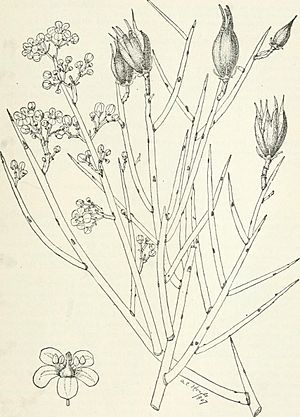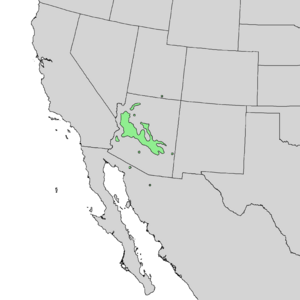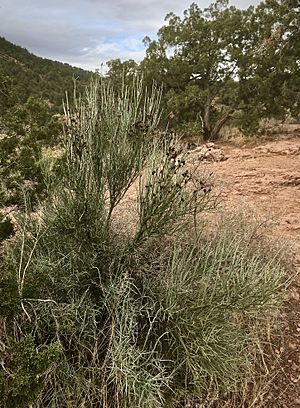Canotia facts for kids
Quick facts for kids Canotia |
|
|---|---|
 |
|
| illustration from Forest Trees of the Pacific Slope | |
| Scientific classification | |
| Genus: |
Canotia
|
| Species: |
holacantha
|
 |
|
| Natural range of Canotia holacantha | |

Canotia holacantha, often called crucifixion thorn, is a special kind of flowering shrub or small tree. It belongs to the Celastraceae plant family. What makes it extra unique is that it's the only species in its group, called Canotia!
Contents
Where Canotia Grows
This plant naturally grows in the higher deserts of the Southwestern United States. You can find it in Arizona and southeastern California. It also grows in parts of Northwest Mexico, like Baja California and Sonora.
Canotia likes to live in desert areas. It often grows on hillsides or in dry riverbeds called washes. You can spot it in the higher parts of the Sonoran Desert across central Arizona. It also reaches into the Mojave Desert in California and northwest Arizona. You might even see it in the lower areas of the Grand Canyon.
Canotia in Ancient Times
Scientists have studied old pollen to learn where Canotia grew long ago. For example, in the Waterman Mountains of Arizona, they found Canotia pollen from the last Ice Age. This shows that Canotia grew there alongside trees like Juniperus osteosperma and Pinus monophylla.
What Canotia Looks Like
Most Canotia plants grow to be about 10 to 15 feet (3 to 4.5 meters) tall. However, one very tall Canotia plant was found near Wikieup, Arizona. It was over 30 feet (9 meters) tall!
Canotia usually looks like a bushy plant. It has gray-green branches that end in sharp thorns.
How Canotia Makes Food
Unlike most plants, Canotia doesn't use its leaves much for making food. Its leaves are tiny and fall off quickly, so you rarely see them. Instead, Canotia uses its twigs to do photosynthesis. This is how plants turn sunlight into energy. Another plant, the Foothill palo verde, also uses its twigs for this!
You can easily spot Canotia's seed pods. They are reddish-brown capsules that hang in groups of five. These pods stay on the plant for a long time.
Other Names for Canotia
People have given Canotia many names. Some common names in Spanish are chaparro amargosa, corona-de-cristo, and rosario. All these names refer to its thorny branches. They remind people of the Crown of Thorns.
The name "crucifixion thorn" is also used for other thorny plants. Some of these plants grow in the same areas as Canotia. Examples include Castela emoryi and Koeberlinia spinosa.
During World War II, a ship was named after this tree. It was the Ailanthus-class net laying ship USS Canotia (AN-47).
You can grow Canotia plants from their seeds.
See also
 In Spanish: Canotia para niños
In Spanish: Canotia para niños

